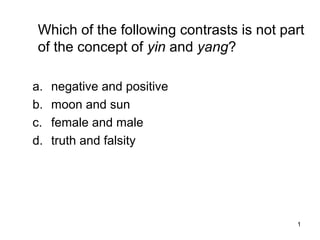
Yin Yang Concept Quiz: Truth vs Falsity Not Included
- 1. 1 Which of the following contrasts is not part of the concept of yin and yang? a. negative and positive b. moon and sun c. female and male d. truth and falsity
- 2. 2 Which of the following contrasts is not part of the concept of yin and yang? a. negative and positive b. moon and sun c. female and male d. truth and falsity
- 3. 3 During the Cultural Revolution, ___ were repressed. a. all religions b. no religions c. only native Chinese religions d. only western religions
- 4. 4 During the Cultural Revolution, ___ were repressed. a. all religions b. no religions c. only native Chinese religions d. only western religions
- 5. 5 Which of the following best describes traditional Chinese attitudes toward ancestors? a. reverent remembrance b. willful ignorance c. religious worship as of gods/goddesses d. easy familiarity
- 6. 6 Which of the following best describes traditional Chinese attitudes toward ancestors? a. reverent remembrance b. willful ignorance c. religious worship as of gods/goddesses d. easy familiarity
- 7. 7 Which of the following would be most consistent with a Taoist perspective on life? a. Training to be an honorable warrior. b. Running for elected political office. c. Imitating the playfulness and innocence of children. d. Offering sacrifices to placate the Gods.
- 8. 8 Which of the following would be most consistent with a Taoist perspective on life? a. Training to be an honorable warrior. b. Running for elected political office. c. Imitating the playfulness and innocence of children. d. Offering sacrifices to placate the Gods.
- 9. 9 The Confucian philosopher Mencius: a. radically changed the teachings of Confucius. b. believed in the inherent wickedness of humans. c. opposed any and all forms of government. d. none of the above.
- 10. 10 The Confucian philosopher Mencius: a. radically changed the teachings of Confucius. b. believed in the inherent wickedness of humans. c. opposed any and all forms of government. d. none of the above.
- 11. 11 The Chou Dynasty introduced into China the idea that a Supreme High God appointed rulers and held them accountable to His moral standards. a. True b. False
- 12. 12 The Chou Dynasty introduced into China the idea that a Supreme High God appointed rulers and held them accountable to His moral standards. a. True b. False
- 13. 13 Overall Chinese history is characterized by intense religious warfare in which members of different religions persecute and kill all those who do not belong to their sect. a. True b. False
- 14. 14 Overall Chinese history is characterized by intense religious warfare in which members of different religions persecute and kill all those who do not belong to their sect. a. True b. False
- 15. 15 Confucius believed that the root of most evil in the world could be traced to social and disrespect for social rank and hierarchy. a. True b. False
- 16. 16 Confucius believed that the root of most evil in the world could be traced to social and disrespect for social rank and hierarchy. a. True b. False
- 17. 17 The Tao Tê Ching teaches that there is a personal High God who is unchanging and who will judge all people at the end of time. a. True b. False
- 18. 18 The Tao Tê Ching teaches that there is a personal High God who is unchanging and who will judge all people at the end of time. a. True b. False
- 19. 19 Confucianism became extremely influential in China because the government outlawed it, thereby giving it in the eyes of many an allure as a dissident, outsider religion of absolute moral purity. a. True b. False
- 20. 20 Confucianism became extremely influential in China because the government outlawed it, thereby giving it in the eyes of many an allure as a dissident, outsider religion of absolute moral purity. a. True b. False